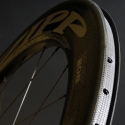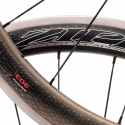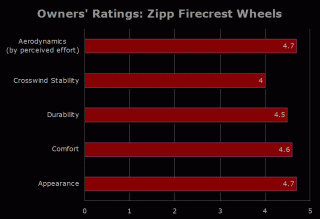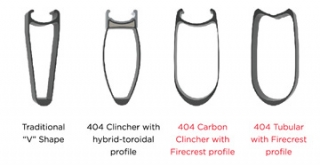
As we mentioned in our recent review of Shimano’s new Ultegra wheelset, more so than any other component, upgrading your wheels can make a huge difference in the performance and ride quality of your bike. Wheel manufacturers are constantly striving to create the smoothest riding, lightest, most aerodynamic wheel for professional racers and recreational enthusiasts alike.
Zipp Speed Weaponry has been pushing the boundaries of bicycle wheel aerodynamics since their inception in the late 1980's. Their design goal is stated right in their name: Speed Weaponry, tools to make you faster. The development of carbon fiber technology has taken the bicycle wheel into new realms of performance, with Zipp leading the industry.
Never a company to become complacent, Zipp has continued to question accepted aerodynamic principles. Their new Firecrest line of wheels mark a distinct departure from previous rim designs. With their bulbous shape, Zipp says that the Firecrest design controls airflow around both the front and back edge of the rim, creating a faster wheel that is also significantly more stable in crosswinds.
At Signature Cycles, we love anything that will make us faster on the bike. While our initial road tests of the Zipp Firecrest wheels were extremely promising, we wanted to hear from the owners who have been riding these wheels every day. For the third edition of our Owner’s Survey series, we asked our customers to report on all aspects of these wheels to find out how they stack up in a competitive market.

There are currently six models in the Zipp Firecrest line. The 303, 404 and 808 wheelsets have a rim depth of 45mm, 58mm and 81mm respectively, and each is available in a tubular or carbon clincher version. Of the owners responding to our survey, the majority own the 404 carbon clincher, with three 808 tubular sets, one 808 clincher, and one 303 tubular rounding out the mix.
Zipp introduced the Firecrest design roughly 18 months ago. 60% of our respondents were early adopters, having owned the wheels for a year or more. The remaining owners had spent between three and six months riding their sets.
We asked Zipp riders to compare their Firecrest rims with other carbon wheelsets, including previous Zipp models. 75% of those responding had owned a pair of carbon wheels in the past. HED was the most popular competing brand in our survey, with Mavic, Enve, and Lightweight also receiving mentions. However many Firecrest owners came off a previous set of Zipps.
The new wheels compare very favorably to other wheels, “comfort”, “handling”, and “stability” were commonly listed advantages. Two of our more succinct respondents described the wheels as being “very fast”, and “smoother and faster.” While another rider went into more detail, saying “I’ve set my PR’s over previous races using the 404’s.”
Disadvantages were reassuringly sparse, a few owner’s simply wrote “none.” Price was a drawback for some and another responded that “braking when wet takes longer than aluminum wheels”, although both of those are true of nearly all carbon wheels. One rider mentioned that the wide Firecrest rim profile caused compatibility issues with certain brands of brake calipers.

The Zipp Firecrest report card showed that aerodynamics and appearance were the wheels best attributes. Both scored 4.7 out of a possible 5, according to the owners. Comfort and durability were rated 4.6 and 4.5 respectively, while crosswind stability was given a still respectable 4.0
Zipp saved their perfect score for our final question, “would you recommend Zipp Firecrest wheels to a friend?” 100% of responding owners answered “yes.”
 As we mentioned in our recent review of Shimano’s new Ultegra wheelset, more so than any other component, upgrading your wheels can make a huge difference in the performance and ride quality of your bike. Wheel manufacturers are constantly striving to create the smoothest riding, lightest, most aerodynamic wheel for professional racers and recreational enthusiasts alike.
Zipp Speed Weaponry has been pushing the boundaries of bicycle wheel aerodynamics since their inception in the late 1980's. Their design goal is stated right in their name: Speed Weaponry, tools to make you faster. The development of carbon fiber technology has taken the bicycle wheel into new realms of performance, with Zipp leading the industry.
Never a company to become complacent, Zipp has continued to question accepted aerodynamic principles. Their new Firecrest line of wheels mark a distinct departure from previous rim designs. With their bulbous shape, Zipp says that the Firecrest design controls airflow around both the front and back edge of the rim, creating a faster wheel that is also significantly more stable in crosswinds.
At Signature Cycles, we love anything that will make us faster on the bike. While our initial road tests of the Zipp Firecrest wheels were extremely promising, we wanted to hear from the owners who have been riding these wheels every day. For the third edition of our Owner’s Survey series, we asked our customers to report on all aspects of these wheels to find out how they stack up in a competitive market.
As we mentioned in our recent review of Shimano’s new Ultegra wheelset, more so than any other component, upgrading your wheels can make a huge difference in the performance and ride quality of your bike. Wheel manufacturers are constantly striving to create the smoothest riding, lightest, most aerodynamic wheel for professional racers and recreational enthusiasts alike.
Zipp Speed Weaponry has been pushing the boundaries of bicycle wheel aerodynamics since their inception in the late 1980's. Their design goal is stated right in their name: Speed Weaponry, tools to make you faster. The development of carbon fiber technology has taken the bicycle wheel into new realms of performance, with Zipp leading the industry.
Never a company to become complacent, Zipp has continued to question accepted aerodynamic principles. Their new Firecrest line of wheels mark a distinct departure from previous rim designs. With their bulbous shape, Zipp says that the Firecrest design controls airflow around both the front and back edge of the rim, creating a faster wheel that is also significantly more stable in crosswinds.
At Signature Cycles, we love anything that will make us faster on the bike. While our initial road tests of the Zipp Firecrest wheels were extremely promising, we wanted to hear from the owners who have been riding these wheels every day. For the third edition of our Owner’s Survey series, we asked our customers to report on all aspects of these wheels to find out how they stack up in a competitive market.
 There are currently six models in the Zipp Firecrest line. The 303, 404 and 808 wheelsets have a rim depth of 45mm, 58mm and 81mm respectively, and each is available in a tubular or carbon clincher version. Of the owners responding to our survey, the majority own the 404 carbon clincher, with three 808 tubular sets, one 808 clincher, and one 303 tubular rounding out the mix.
Zipp introduced the Firecrest design roughly 18 months ago. 60% of our respondents were early adopters, having owned the wheels for a year or more. The remaining owners had spent between three and six months riding their sets.
We asked Zipp riders to compare their Firecrest rims with other carbon wheelsets, including previous Zipp models. 75% of those responding had owned a pair of carbon wheels in the past. HED was the most popular competing brand in our survey, with Mavic, Enve, and Lightweight also receiving mentions. However many Firecrest owners came off a previous set of Zipps.
The new wheels compare very favorably to other wheels, “comfort”, “handling”, and “stability” were commonly listed advantages. Two of our more succinct respondents described the wheels as being “very fast”, and “smoother and faster.” While another rider went into more detail, saying “I’ve set my PR’s over previous races using the 404’s.”
Disadvantages were reassuringly sparse, a few owner’s simply wrote “none.” Price was a drawback for some and another responded that “braking when wet takes longer than aluminum wheels”, although both of those are true of nearly all carbon wheels. One rider mentioned that the wide Firecrest rim profile caused compatibility issues with certain brands of brake calipers.
The Zipp Firecrest report card showed that aerodynamics and appearance were the wheels best attributes. Both scored 4.7 out of a possible 5, according to the owners. Comfort and durability were rated 4.6 and 4.5 respectively, while crosswind stability was given a still respectable 4.0
Zipp saved their perfect score for our final question, “would you recommend Zipp Firecrest wheels to a friend?” 100% of responding owners answered “yes.”
There are currently six models in the Zipp Firecrest line. The 303, 404 and 808 wheelsets have a rim depth of 45mm, 58mm and 81mm respectively, and each is available in a tubular or carbon clincher version. Of the owners responding to our survey, the majority own the 404 carbon clincher, with three 808 tubular sets, one 808 clincher, and one 303 tubular rounding out the mix.
Zipp introduced the Firecrest design roughly 18 months ago. 60% of our respondents were early adopters, having owned the wheels for a year or more. The remaining owners had spent between three and six months riding their sets.
We asked Zipp riders to compare their Firecrest rims with other carbon wheelsets, including previous Zipp models. 75% of those responding had owned a pair of carbon wheels in the past. HED was the most popular competing brand in our survey, with Mavic, Enve, and Lightweight also receiving mentions. However many Firecrest owners came off a previous set of Zipps.
The new wheels compare very favorably to other wheels, “comfort”, “handling”, and “stability” were commonly listed advantages. Two of our more succinct respondents described the wheels as being “very fast”, and “smoother and faster.” While another rider went into more detail, saying “I’ve set my PR’s over previous races using the 404’s.”
Disadvantages were reassuringly sparse, a few owner’s simply wrote “none.” Price was a drawback for some and another responded that “braking when wet takes longer than aluminum wheels”, although both of those are true of nearly all carbon wheels. One rider mentioned that the wide Firecrest rim profile caused compatibility issues with certain brands of brake calipers.
The Zipp Firecrest report card showed that aerodynamics and appearance were the wheels best attributes. Both scored 4.7 out of a possible 5, according to the owners. Comfort and durability were rated 4.6 and 4.5 respectively, while crosswind stability was given a still respectable 4.0
Zipp saved their perfect score for our final question, “would you recommend Zipp Firecrest wheels to a friend?” 100% of responding owners answered “yes.” 

